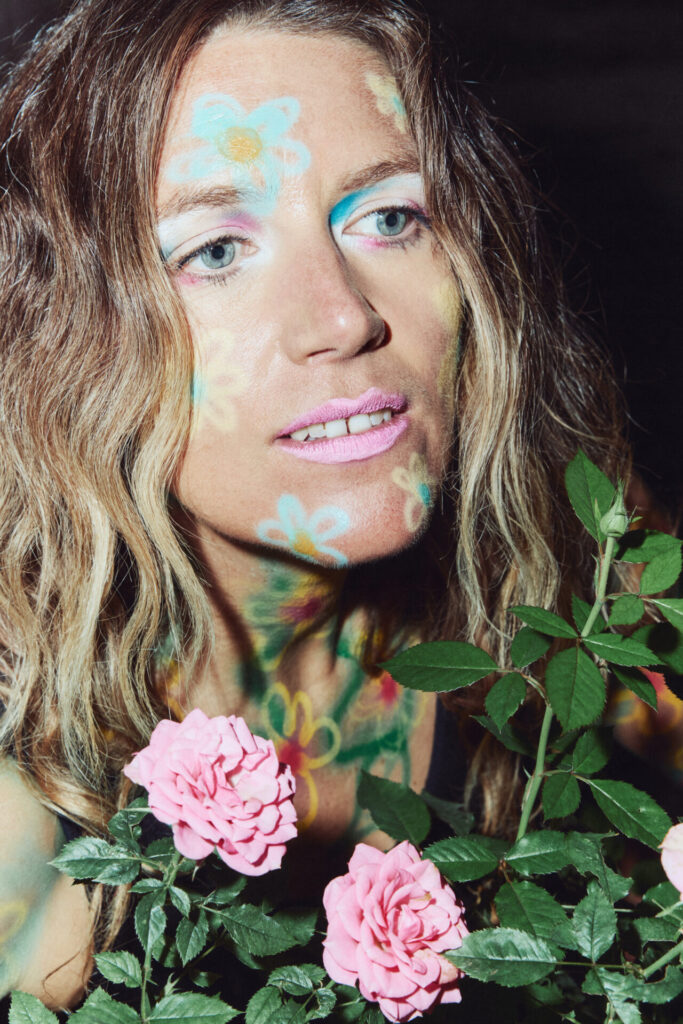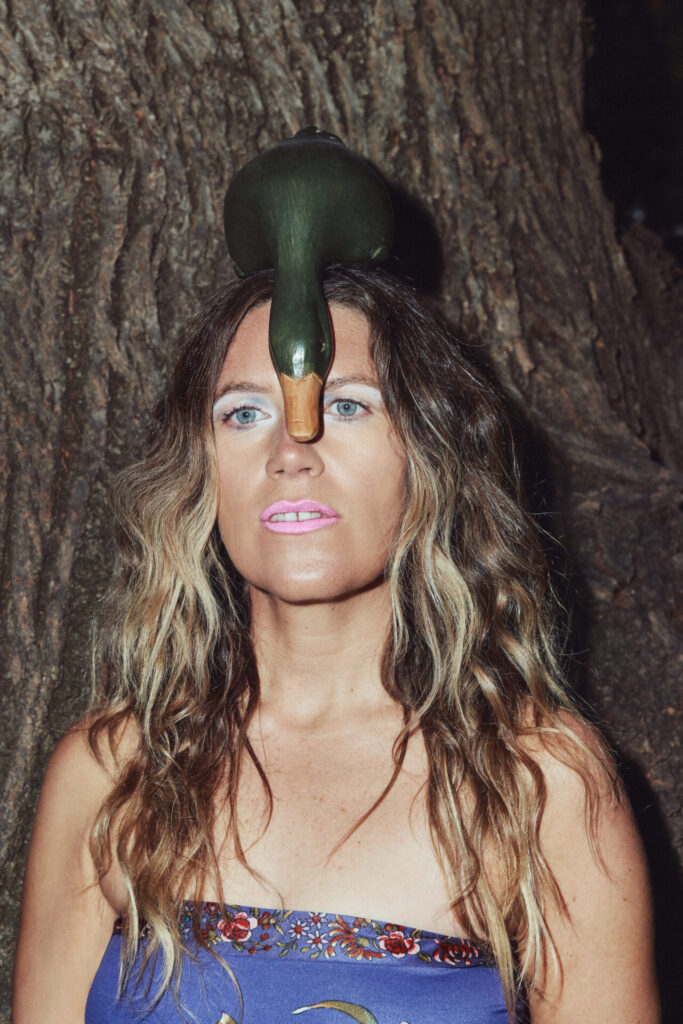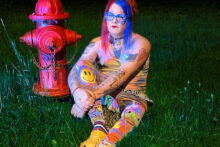“I wanted to make something that sounds natural and unnatural at the same time,” says Jasamine White-Gluz of No Joy, whose fifth album Bugland is inspired by the chaos and excess of nature, and a recent move from Montreal to rural Quebec. ”There’s a trope where you move to the country and your music becomes folk or more organic sounding, but for me it was the opposite,” she explains. “I was like, plug everything in, run it through lots of things. It was so much more maximalist, just because that was what nature was giving me.”
Formed in 2009 as a four-piece shoegaze band, No Joy became a solo project around the time of 2020’s Motherhood, an acclaimed album exploring complicated familial feelings. It saw White-Gluz incorporate more beats and electronics into her sound, drawing comparisons to everything from nu-metal to The Chemical Brothers. “With Motherhood, I was very influenced by a particular year: 1998, when I was a kid buying records,” she explains. “So with this record, I was trying not to be super nostalgic. I wanted to be more like: this plant isn’t going anywhere. It’s going to be here no matter what the trend is.” Fittingly, Bugland is difficult to categorise by genre; it’s better understood as an eternal core of pure, earnest pop, with stylistic tendons growing and evolving outwards.
Although her move to the country is recent, White-Gluz has always had close ties to the natural world. “I grew up in a household of animal rights activists, and we would often say that we liked animals more than people,” she laughs. “When you’re in the city, you can lie to yourself and say, I’m a city slicker, I love being out all night. But then I moved and I was like – wait, waking up to birdsong is amazing. I have a little water feature, and I can see a frog taking a bath. It’s crazy!” Now, she grows vegetables, keeps plum trees and cultivates lilypads. “It’s kind of a cheesy comparison, but it’s almost like guitar pedals. You’re in the garden like, I could probably plant another thing here…” she laughs. “I feel like nature has always been part of me. It was just a bit less tended to for a little while.”
Like her garden – and like Motherhood – Bugland is both technically and conceptually maximalist, stuffed with sonic intricacy and anthemic songwriting. “I was influenced by artists that were taking strange risks in the studio, like Boards Of Canada, and Zooropa by U2,” White-Gluz says, referring to the 1993 album whose electronic experiments were radical in the context of stadium rock. “I only have a CD player in my car, and I like to listen to CDs that I find at the thrift store. Sometimes you’re almost home, but there’s a little bit left on the CD, so you take a longer way – Zoorapa is one of those. I wanted to make something like that.”
With these ambitions in mind, White-Gluz reached out to Angel Marcloid, aka producer and multi-instrumentalist Fire-Toolz. An ultra-prolific musician, Marcloid is an expert at cutting through hectic amalgamations of speed metal, electronics and noise with hooks and humour. “I like when music really confuses me the first time I hear it,” White-Gluz says of Marcloid’s work as Fire-Toolz. “There’s so much going on, but she always had great melodies. She’s able to create craziness and then break it up for a second and have this amazing hook that gets stuck in your head.” Marcloid was brought onto the project as co-producer, joining a lineage of No Joy collaborators including Peter Kember (Sonic Boom, ex-Spacemen 3) and Jorge Elbrecht (producer for Japanese Breakfast, Sky Ferreira).
White-Gluz and Marcloid quickly realised they shared many influences, approaches, and creative languages. “It was clear from the beginning how creatively compatible we were,” says Marcloid over email. “Pretty much any artist one of us would mention was a hit with both of us. I got her into Type O Negative because I could tell from her music that she would dig them, even though No Joy and Type O sound vastly different. When she brought up references like ‘Boards Of Canada if they were a noise band’ and Enya’s big walls of vocal harmonies, she was speaking my language.” This connection led to a closer collaboration than between most artists and producers, with Marcloid acting as a co-writer too.
Trading files back and forth between their home studios in Quebec and Illinois – where Marcloid had also relocated to a more rural area – the two musicians pushed each other to take musical risks and run with their strange ideas. White-Gluz would send folders of stems from “late night sessions using Ableton, trying to make loops and beats and being like, ‘I’m Oneohtrix Point Never!’” – which Marcloid would collage together. “I would stay up all night arranging and mixing and adding things,” says Marcloid. “I fully knew that she might just hate it all, which is the risk you take when you do this kind of work with collaborators. But usually they would only inspire her more, and she’d go record a bunch more guitars and a bunch of vocal ideas.” The pair would quite literally road test the tracks to check their anthemic, CD-in-the-car credentials. “We would get in our cars and drive around the countryside listening to the mixes,” White-Gluz remembers. “If you’re skipping or changing the volume in between songs, you gotta go back.”

For the title track, Marcloid turned an almost decade-old demo into a cotton-candy Cocteau Twins hit wrapped in dance-rock crunch. “I knew it had something, but it needed the right circumstances to really come together.” says White-Gluz, who admits to “hoarding” her demos to return to when the time is right. “I brought that demo to Angel and she added a crazy Korn bassline. As soon as I heard her version the vocals came to me, and I did them all in one.” Marcloid has a featured artist credit on album closer ‘Jelly Meadow Bright’, which morphs from celestial dream pop into a beats-and-saxophone freakout, the Zooropa and Enya influences front-and-centre. “She completely dissected that song and pieced it back together,” says White-Gluz. “When I collaborate with somebody like Angel, I want her to do her thing and I do mine. I’m not a perfectionist, which helps. But I don’t want to put anything out if it’s not something I would listen to non-stop.”
In contrast to the expansive, outward-looking production of the instrumentation and electronics, White-Gluz’s vocals are particularly intimate. Whether surrounded with noise (‘My Crud Princess’) or exposed and swathed in reverb (“I Hate That I Forget What You look Like’), White-Gluz sounds like she’s spilling secrets in your ear. This is by design: “I recorded the vocals in my closet!” she admits. “It’s not that big, there’s a lot of vintage clothing hanging up. I can sing in the dark and pretend I’m somewhere else. It’s like Narnia. I wanted the vocals to be a little more upfront in the mix, because it’s a very personal album.” White-Gluz’s lyrics are always the last addition to her songs, and her approach is more felt than intellectualised. “The initial lyrics are often nonsensical, stream of consciousness – sometimes they are kind of cool, and I keep them,” she explains. “I always like to create soundscapes or textures that will evoke something versus a lyric that might evoke, so I’m hoping that the lyric and the sonic can work together to create an emotional reaction.”
White-Gluz also kept a list of nature-inspired words to build around, or try to fit into melodies. “I would look through wildflower books,” she says of this process. “I’d take elegant sounding words and put them in a basic sentence and see how they take on new meaning. Words for flowering and buds, growth and regeneration. There were a lot of observations too. One day I saw some beetles destroying a peach tree; I was just watching them rip it apart. That idea of stripping a tree went on the list.” In ‘Bits’, the destruction and sticky debris of nature is comparable to all-consuming desire (“Forest litter… I walk around the back and you’re all around me”). This dichotomy of seduction and repulsion is all over Bugland. “I’ve always been fascinated by the beauty and the grossness, the textures and colours and smells of nature. I tried to capture some of that and make that sonic.”
She’s also been extending these explorations into video collaborations with her friends and her husband, artist Jeremy Dabrowski, “because the whole concept of the record was home and nature, and nobody understands it better than him.” In the video for ‘Bugland’, she frolics around a day-glo garden in an orange and pink flower dress by Tristan Reìhel, like a horticultural Pee-Wee Herman.
The album’s cover features a snail in silhouette, inspired by one of her favourite records. “Mezzanine by Massive Attack has a beetle on the cover,” she explains. “I don’t think I would listen to that record the same way if I didn’t have that visual in my mind. So I tried to do my own version, even if it was a little gross.” White-Gluz ethically sourced some bugs from “a bug guy who does educational bug tours”, and had them photographed by her friend, fashion photographer Mathieu Fortin, who applied his approach to a slimier than usual coterie of models. “There were stick bugs, spiders, a praying mantis who was kind of a diva,” White-Gluz remembers of the shoot in Fortin’s house. “I wasn’t too grossed out. I loved them. It was fun to play with them and get a good look at them. And the snail [on the cover] was a model. He knew his angles, knew how to work it for sure.”
In September, White-Gluz takes this more organic incarnation of No Joy on the road, for dates in North America, the UK and Europe. “I want to play around with stuff, now things are a little more electronic and improv,” she says of her hopes for the tour. “I’ve been using a vocal effect rig that I can play with, and I can be looser when it comes to guitar work.” In the meantime, she’s continuing to bask – and take solace – in her chaotic bucolic surroundings. “The fireflies have been so amazing this year – at night it’s like a strobe light,” she says. “I feel like it’s a coping mechanism when the world is really heavy. Just stare at a flower for a little while, it takes your mind off things.”
No Joy’s new album Bugland is released on 8 August via Sonic Cathedral




